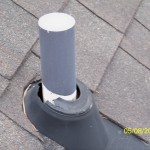
Lead jack flashing is commonly used to cover plumbing vents in residential and commercial construction, the plumbing vent stack (usually comprised of galvanized pipe or PVC tubing) extending up through the plywood or roof decking and the lead jack being fitted over the vent stack with the shingles overlapping the flashing around the vent. After the lead is fitted over the vent stack and secured to the roofing deck, the tubular portion, having a length substantially longer than that of the protruding vent stack, is manually hammered and forced over the digital end of
the vent stack and down into the vent to effect a weatherproof seal against wind and rain entering the building around the vent stack. Lead jacks are so well known and commonly used that they are available from several manufacturers, including Construction Metals, Inc. (Fontana, CA), Santa Rosa Lead (Ontario, CA), F.J. Moore Manufacturing Co. (Cannon Fall, MN), Nuclead Co., Inc./Sharp Manufacturing, Inc. (West Bridgewater, MA), and Mayco Industries, Inc. (Birmingham, AL).
Although lead jack flashings are the premium flashing material for roof vents – a roofing accessory that will last as long as the shingle material -unfortunately, they are a favorite target of squirrels, which gnaw on the lead to wear down their teeth. Other animals may also attack the lead jacks, but squirrels are particularly persistent and so destructive that sooner or later (sometimes as soon as one day) the weatherproofing integrity is substantially comprised. Of course if the lead flashing is chewed sufficiently to form a hole, rainwater will enter the building.

The alternative to lead jack flashing is usually an inferior product that may only last a few years or compromise the venting capabilities of the sewer vent. The ‘auto-caulk’ – a rubber seal attached to a plastic or metal base is often utilized by inferior roofing contractors and builders roofing crews due to the low cost and flexibility of “one size fits most”. Unfortunately due to the ultra-violet rays and extreme heat on the roof, the rubber gaskets deteriorate very quickly (5-7 years) allowing rain water to enter the building. Repairs usually result in an unsightly roof/shingle repair or a continuous caulking of the rubber vent flashings – a problem on the dangerous roof slopes.

Another alternative, often utilized when squirrel damage was previously detected, is the Tapered Roof Jack with Vent Cap. This vent flashing is typically galvanized or aluminum in material and come in various pitch sizes in multiples of three. For example, a vent designed for a 4/12 pitch is also used on 3/12 pitch and 5/12 pitch, meaning only a one in three chance that the vent will be sitting perpendicular to the ground. If the appearance of the roofing system is important, then the incorrect pitch can make an otherwise attractive roof look poorly executed. These vents are also easy prey for squirrels and other critters to enter, build their nest inside the vent and often times access the attic of a home. The tapered roof jack vent cap has a higher probability of leaking in wind driven rain storms than the other available flashings. Another detriment of the tapered roof jack with vent cap is that in the instance where a plumber needs to ‘snake’ a clogged drain, the vent must be removed which can violate the roofing shingles and cause future leaks or unsightly roof repairs.
Lead jack flashing seems to ‘win out’ on premium roof installations for the highest quality and longest lasting vent flashing with the one exception of squirrel damage. When protected by the new patent pending SquirrelGard™ the lead flashing becomes the hands down best alternative for flashing plumbing vent stacks on the roof.